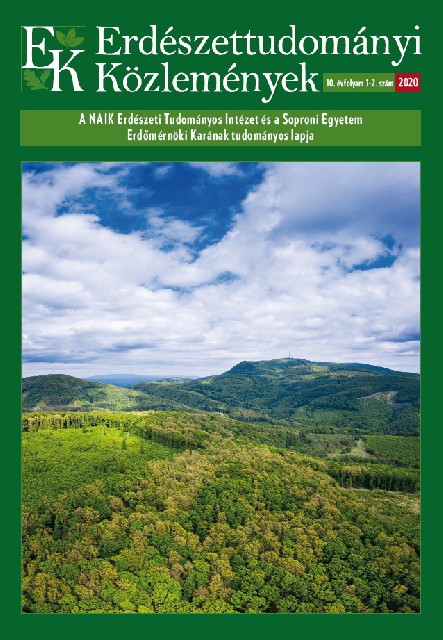| 1. | Bartoń K. 2019: MuMIn: Multi-Model Inference. R package version 1.43.15. URL |
| 2. | Covington W.W. 1981: Changes in forest floor organic matter and nutrient content following clear cutting in Northern Hardwoods. Ecology 62(1): 41–48. DOI: 10.2307/1936666 |
| 3. | Führer E. 1994: Csapadékmérések bükkös, kocsánytalan tölgyes és lucfenyves ökoszisztémában. Erdészeti Kutatások 84: 11–35. |
| 4. | Führer E., Heil B., Heilig D., Jagodics A. & Kovács G. 2019: Termőhelyi viszonyok. In: Führer E. (ed): Magyarország erdészeti tájai. III. Dunántúli-középhegység erdészeti tájcsoport, Nemzeti Földügyi Központ, Budapest, 126–137. |
| 5. | Gácsi Zs. 2000: A talajvízszint észlelés, mint hagyományos, és a vízforgalmi modellezés, mint új módszer alföldi erdeink vízháztartásának vizsgálatában. Doktori (Ph.D) értekezés, Nyugat-Magyarországi Egyetem, Sopron. |
| 6. | Green, R.H. 1979: Sampling desing and statistical methods for environmental biologist. John Wiley and Sons Inc., New York. |
| 7. | Huang, W. & Spohn, M. 2015: Effects of long-term litter manipulation on soil carbon, nitrogen and phosphorus in temperate deciduous forest. Soil Biology & Biochemistry 83: 12–18. DOI: 10.1016/j.soilbio.2015.01.011 |
| 8. | Járó Z. 1958: Alommennyiségek a magyar erdők egyes típusaiban. Erdészettudományi Közlemények 1958. 151–162. |
| 9. | Keenan R.J. & Kimmins J.P. 1993: The ecological effects of clear-cutting. Environmental Reviews 1: 121–144. |
| 10. | Kondorné Sz. M. 2007: Fafaj-összehasonlító kísérletek értékelése. Doktori (Ph.D) értekezés, Nyugat-Magyarországi Egyetem, Sopron. |
| 11. | Kotroczó Zs., Biró B., Kocsis T., Veres Zs., Tóth A. & Fekete I. 2017: Hosszú távú szerves anyag manipuláció hatása a talaj biológiai aktivitására. Talajvédelem 73–83. |
| 12. | Kovács B., Tinya F., Guba E., Németh,C., Sass V., Bidló A. & Ódor P. 2018: The short-term effects of experimental forestry treatments on site conditions in an oak-hornbeam forest. Forests 9: 406. DOI: 10.3390/f9070406 |
| 13. | Kovács B., Tinya F., Németh Cs. & Ódor P. 2020: Unfolding the effects of different forestry treatments on microclimate in oak forests: results of a 4-year experiment. Ecological Applications 30(2): e02043. DOI: 10.1002/eap.2043 |
| 14. | Lenth R.W. 2016: Least-Squares Means: The R Package lsmeans. Journal of Statistical Software 69(1): 1–33. DOI: 10.18637/jss.v069.i01 |
| 15. | Muscolo A., Sidari M. & Mercurio R. 2007: Influence of gap size on organic matter decomposition, microbial biomass and nutrient cycle in Calabrian pine (Pinus laricio, Poiret) stands. Forest Ecology and Management 242: 412–418. DOI: 10.1016/j.foreco.2007.01.058 |
| 16. | MSZ-08-0206/2: 1978: A talaj egyes kémiai tulajdonságainak vizsgálata. Laboratóriumi vizsgálatok. (pH-érték, szódában kifejezett fenolftalein lúgosság, vízben oldható összes só, hidrolitos (y1-érték) és kicserélődési aciditás (y2-érték) |
| 17. | Ódor P., Tinya F., Kovács B., Aszalós R., Bidló A., Boros G. et al. 2020: Különböző erdészeti beavatkozások termőhelyre, biodiverzitásra, és felújulásra gyakorolt hatása gyertyános tölgyesekben. Beszámoló egy 5 éve indult erdőökológiai kísérlet eredményeiről. Erdészeti Lapok 155(1): 8–12. full text |
| 18. | Pinheiro J., Bates D., DebRoy S., Sarkar D. & R Core Team 2020: nlme: Linear and Nonlinear Mixed Effects Models_.R package version 3.1–144. URL |
| 19. | Prescott C.E. 2002: The influence of the forest canopy on nutrient cycling. Tree Physiology 22: 1193–1200. DOI: 10.1093/treephys/22.15-16.1193 |
| 20. | R Core Team 2020: R: A language and environment for statistical computing. R Foundation for Statistical Computing, Vienna, Austria. URL |
| 21. | Reiczigel J., Harnos A. & Solymosi N. 2007: Biostatisztika nem statisztikusoknak. Pars Kft., Nagykovácsi. |
| 22. | Ritter E. 2005: Litter decomposition and nitrogen mineralization in newly formed gaps in a Danish beech (Fagus sylvatica) forest. Soil Biology & Biochemistry 37: 1237–1247. DOI: 10.1016/j.soilbio.2004.11.020 |
| 23. | Snyder K.E., & Harter R.D. 1987: Forest floor dynamics in even-aged northern hardwood stands. Soil Science Society of America Journal 51: 1381–1383. DOI: 10.2136/sssaj1987.03615995005100050052x |
| 24. | Tinya F., Kovács B., Aszalós R., Tóth B., Csépányi P., Németh Cs. & Ódor P. 2020: Initial regeneration success of tree species after different forestry treatments in a sessile oak-hornbeam forest. Forest Ecology and Management 459: 117810. DOI: 10.1016/j.foreco.2019.117810 |
| 25. | Tinya F., Kovács B., Prättälä A., Farkas P., Aszalós R. & Ódor P. 2019: Initial understory response to experimental silvicultural treatments in a temperate oak-dominated forest. European Journal of Forest Research 138: 65–77. DOI: 10.1007/s10342-018-1154-8 |
| 26. | Van Couwenberghe R., Gegout J.C., Lacombe E., Collet C. 2013: Light and competition gradients fail to explain the coexistence of shade-tolerant Fagus sylvatica and shade-intermediate Quercus petraea seedlings. Annals of Botany 112: 1421–1430. DOI: 10.1093/aob/mct200 |
| 27. | von Lüpke B. 1988: Silvicultural methods of oak regeneration with special respect to shade tolerant mixed species. Forest Ecology and Management 106(1): 19–26. DOI: 10.1016/S0378-1127(97)00235-1 |
| 28. | Zagyvainé Kiss K. A. 2012: Az avarintercepció vizsgálata a Soproni-hegységben. Doktori (Ph.D) értekezés, Nyugatmagyarországi Egyetem, Sopron. |
| 29. | Zagyvainé Kiss K. A., Vastag V., Gribovszki Z. & Kalicz P. 2015: Soil moisture in sessile oak forest gaps. In EGU General Assembly Conference Abstracts (Vol. 17). |
| 30. | Zuur A.F., Ieno E.N., Walker N.J., Saveliev A.A. & Smith G. 2009: Mixed effects models and extension in ecology with R. Springer, New York. DOI: 10.1007/978-0-387-87458-6 |
